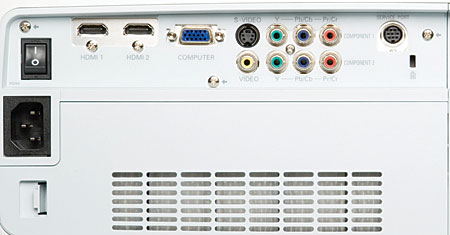Big Screens, Small Prices Sanyo PLV-Z2000
Despite their larger presence in the business realm, Sanyo’s name hasn’t frequented home theater projection circles. The company aims to change that with the introduction of the $2,995 PLV-Z2000. From an aesthetics standpoint, the PLV-Z2000 looks more like a business projector, lacking the gloss and curves of the other models. Both the boxy, white chassis and the remote are utilitarian in design, but they sport most of the features a home theater user would want. In addition to two HDMI 1.3 inputs and a D-sub 15-pin PC connection, this is the only projector to offer two component video inputs. The remote is fully backlit and clearly labeled, with dedicated source buttons and direct access to important video adjustments.

The inclusion of substantial vertical and horizontal lens-shift functions, as well as a high 2x manual zoom, made setting up the PLV-Z2000 a quick and painless process. There’s also manual focus, adjustable feet, and ceiling/tabletop/front/rear projection configurations, but no keystone correction. The lens is protected by a door that automatically opens and closes when you power up/down the unit, which is a nice idea. The menu system, meanwhile, is clear and easy to navigate.

The PLV-Z2000 provides a surprisingly advanced set of image adjustments given its low price, which is a good thing, since its out-of-the-box performance was the least accurate. You get seven preset image modes (we went with Natural) and five color-temperature options, none of which tracks at D65 across the board. The Low2 mode is the closest, but it’s very cool with dark signals. The user menu features Custom Gamma adjustments to fine-tune the highs, mids, and lows for red, green, and blue, as well as global RGB controls to adjust white balance. Through calibration, we were able to dial in a more accurate color temperature, for more neutral skintones and blacks. You can set up each input independently, but your settings are lost whenever you switch between image modes; so, make sure to save your work in one of the seven user modes.
 All three primary color points are oversaturated, and the yellow and magenta points are pretty far off the mark. As I watched high-def NFL games, I consistently questioned the accuracy of the various shades the green grass and of red and blue in uniforms. The projector’s color-management system lets you adjust the phase, level, and gamma of eight colors, but this is best left to a calibrator with advanced measuring equipment.
All three primary color points are oversaturated, and the yellow and magenta points are pretty far off the mark. As I watched high-def NFL games, I consistently questioned the accuracy of the various shades the green grass and of red and blue in uniforms. The projector’s color-management system lets you adjust the phase, level, and gamma of eight colors, but this is best left to a calibrator with advanced measuring equipment.
Through both the HDMI and component video inputs, the PLV-Z2000 correctly deinterlaces 1080i and picks up the 3:2 sequence in film-based content. It cleanly reproduced the staircase in Mission: Impossible III, and the overall level of detail in HD sources was very good. The HDMI inputs accept both 1080p/60 and 1080p/24. As for its handling of 480i content, our favorite Gladiator DVD demo was generally clean and artifact-free, but the projector couldn’t quite handle the torturous Venetian blinds in chapter 4 of the Bourne Identity DVD. I also found upconverted 480i sources to look somewhat soft, so you may want to pair the projector with a good upconverting DVD player.
Happily, digital noise wasn’t a concern through either the HDMI or component video inputs. The light-to-dark transitions in my Lost DVD demo were smooth, and the smoke that hangs over chapter 10 of Ladder 49 looked like smoke, not pixels. With both HD and lesser-quality SD sources, I was impressed with the PLV-Z2000’s ability to render a clean image.
This projector has four lamp modes and a speed-adjustable auto iris. We got the best black level (0.005 ft-L) and light output (11 ft-L) with the projector set to the Auto lamp mode and Fast iris mode. The resulting contrast ratio of 2,200:1 is solid but not as good as the best projectors we’ve seen at this price. The PLV-Z2000 had the highest black level in the roundup, and darker DVD content looked a bit flat in a dark room. Brighter HDTV shows and sporting events benefited from the projector’s solid light output. Black detail in scenes from The Bourne Supremacy and V for Vendetta was excellent. Like many LCD projectors, the PLV-Z2000 struggled with motion blur in test patterns from the FPD Software Group disc.
My main concerns with the PLV-Z2000 were ergonomic in nature. In the Auto lamp modes, I could see and hear the lamp/fan adjustments, and the overall fan noise was fairly audible. In the Eco lamp mode, image brightness is more stable, and the PLV-Z2000 is much quieter, but it’s also dimmer, and the overall contrast ratio drops to 1,314:1. For me, the tradeoff was worth it. Furthermore, the Sanyo does not have automatic aspect-ratio detection or a 12-volt trigger port, and its hidden RS-232 port is of the less common 8-pin mini-DIN variety.
In terms of setup and general performance, the PLV-Z2000 has all the makings of a good entry-level projector, provided you invest some of that financial savings into a professional calibration. Its black level, and aesthetics are just a step behind the best competitors in this price range, but I think we’ll be hearing a lot more from Sanyo in HT circles from this point on.
- Log in or register to post comments






























































